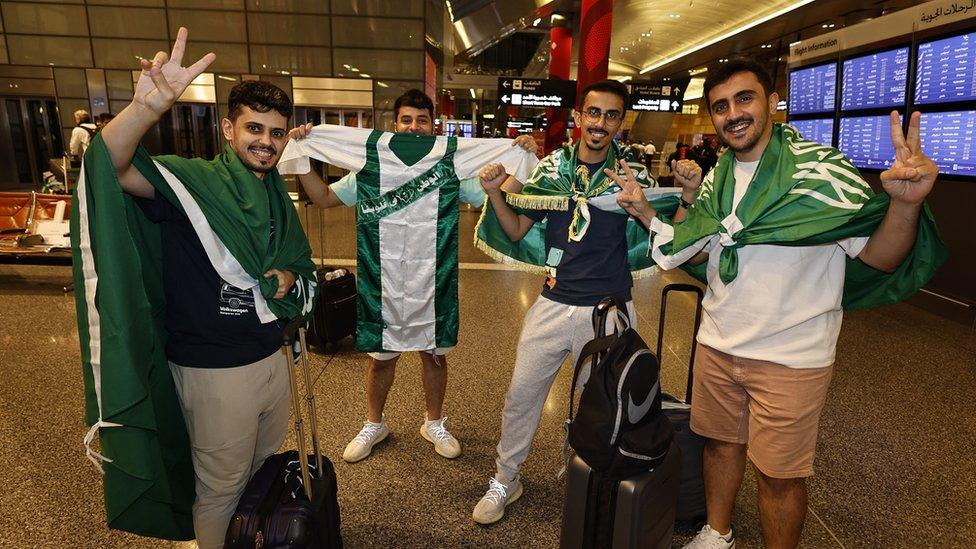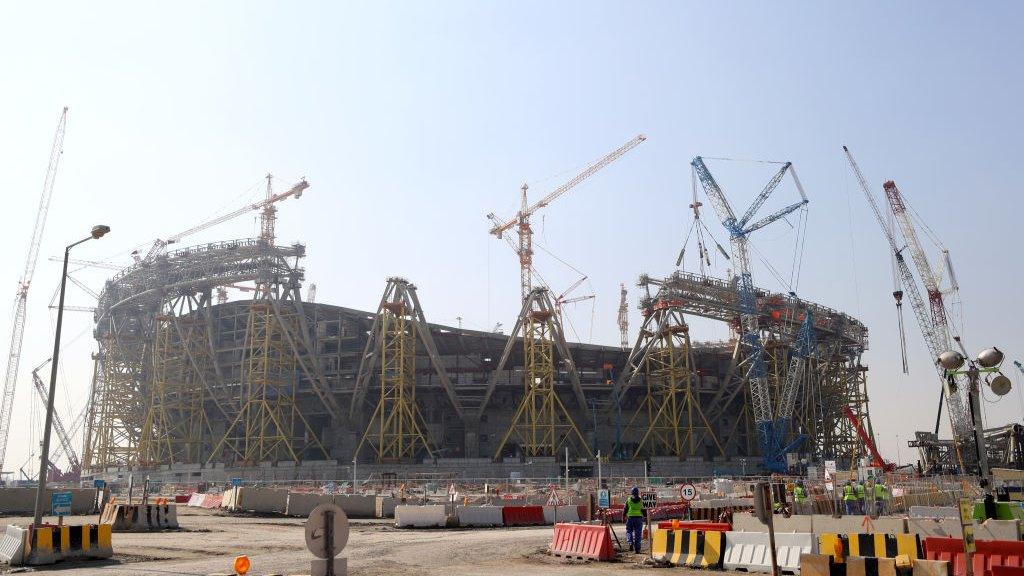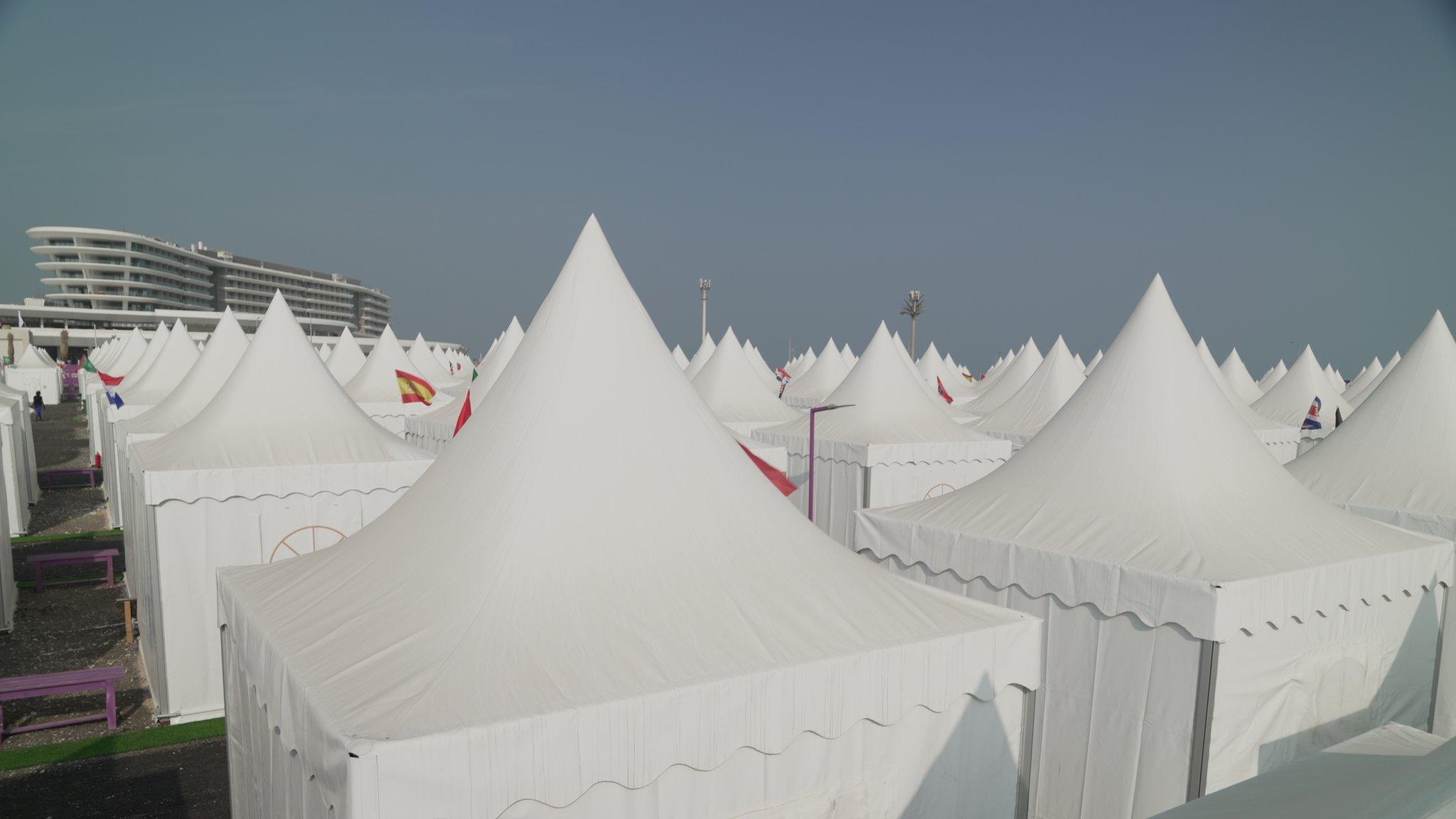World Cup: Shuttle flights cast doubts on carbon-neutral pledge
- Published

Most fans are staying in other Gulf countries and flying in for games due to lack of accommodation in Qatar
In the run-up to the World Cup, Qatar pledged to make this the first carbon-neutral event in the tournament's history. But climate advocates raised serious doubts about its sustainability claims. So, is Qatar living up to its promise?
Due to an acute shortage of hotel rooms in Qatar, tens of thousands of visitors are staying in neighbouring Gulf countries, including the United Arab Emirates.
A shuttle flight service has been set up to take fans to football matches, with an estimated 500 daily flights in and out of Qatar's capital, Doha. Of those, Dubai in the UAE is operating nearly 120 flights every day.
The environmental cost of transporting fans to the host nation by plane has come under scrutiny.
Will the 2022 World Cup be carbon neutral?
The Paris-based carbon accounting firm Greenly estimates the shuttle flights have resulted in between 6,000 and 8,000 tonnes of carbon dioxide (CO2) emissions every day since the tournament started.
The immense volume of shuttle flights undermines the organisers' pledge to minimise flying during the tournament, Khaled Diab, of advocacy group Carbon Market Watch, says.
"One of the rationales for having so many stadiums concentrated in a small geographical area was to help reduce emissions related to air travel," he says.
The World Cup was expected to attract more 1.2 million visitors, but Qatar only had 30,000 hotel rooms, 80% of which were booked in advance by Fifa for football teams, officials and sponsors.
To boost accommodation options, the organisers offered shared rooms in empty apartments, villas, fan villages and traditional-style tents in the desert. But these options turned out to be quite expensive, forcing many fans to look for other avenues.
Dubai has been packed with fans, with the Dubai Sports Council estimating that there would be one million additional visitors during the course of the tournament.

Around 500 flights are operating in and out of Doha daily, bringing fans from neighbouring states
Shuttle flights allow travellers to book same-day round-trip flights from Dubai or other Gulf locations to attend a match in Qatar and return. Private jets and charters are also in huge demand, with hundreds landing in Qatar every day from around the region.
Mr Diab, from Carbon Market Watch, says their use shows the pledge to make the tournament carbon neutral was never serious.
"If they wanted, they could have looked for other solutions, like driving from neighbouring countries," he says.
But Qatar has defended its decisions.
A spokesman for the World Cup Organising Committee says its shuttle service has enabled "efficient direct flights to and from the Fifa World Cup in Qatar".
"Direct flights are significantly more carbon effective than flights with stopovers," he says. "At the same time, because of the compact nature of the tournament, domestic flights will not be taken by fans."
Qatar plans to count emissions produced by the shuttle flights as part of the event's overall carbon footprint.
The organisers expect the World Cup to produce 3.6 million tonnes of carbon dioxide, with travel - the largest contributor - accounting for 52% of it.

Climate advocates say organisers should consider carbon emissions from fans' flights in future
Independent researchers say that figure is grossly underestimated. Greenly CEO Alexis Normand believes the final count will be at least 70% higher.
The 2022 tournament will be "the most emissive ever", he says, adding: "It's a fantasy to consider that this World Cup is carbon-neutral."
To make the tournament carbon-neutral, the organisers announced initiatives including solar-powered stadium air conditioning, purchasing carbon credits to offset emissions, and using shipping containers as building materials.
Qatar built seven new stadiums for the World Cup. One, Stadium 974, external, is made from shipping containers and modular steel, and will be dismantled after the tournament. The others will remain.
In accounting for their carbon footprints, the organisers say these stadiums will be put to meaningful use for decades to come and have assigned them only a small fraction of the emissions associated with their construction.
Mr Normand says this underestimates the true scale of emissions created.
He also says the organisers are relying on purchasing carbon credits to offset emissions, from projects not entirely certified.
Those strategies should change in future, he says: "These large sporting events need to be looked at as an opportunity to invest in decarbonisation, not the other way round."
Related topics
- Attribution
- Published11 June 2021

- Attribution
- Published20 November 2022

- Published25 September 2022
